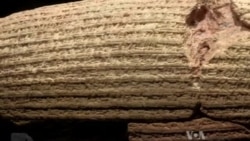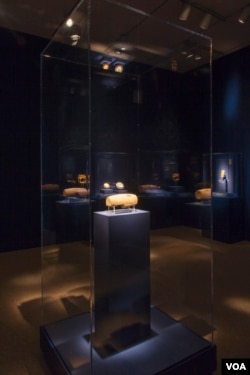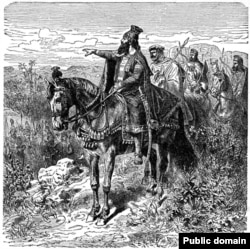An ancient clay cylinder credited with containing the world’s first declaration of human and religious rights, is touring the United States.
Dating from the sixth century BCE, and smaller than an American football, the artifact is inscribed with proclamations from King Cyrus the Great of ancient Persia, present-day Iran, who ruled almost 2,600 years ago.
The words, which declare religious freedom for his newly conquered people, have inspired generations of philosophers and rulers.
Ancient icon
The entire surface of the barrel-shaped cylinder is inscribed in ancient Babylonian cuneiform, one of the earliest written languages.
King Cyrus is one of Persia's best-known historical figures. He founded the Achaemenid Empire (550 - 330 BCE), the world's largest empire, which encompassed the entire present-day Middle East.
Cyrus' cylinder is on loan from the British Museum and was unveiled for the first time in America, at the Smithsonian’s Freer and Sackler Galleries in Washington, in an exhibit entitled, "The Cyrus Cylinder and Ancient Persia: A New Beginning."
“Why this object is so important is because it’s probably the first time in human history that we have evidence of a ruler thinking about how you manage a society with people of different traditions, different languages, different ethnicities, and above all, different religions,” says Neil MacGregor, director of the British Museum.
Babylon
The cylinder was buried in Babylon, present-day Iraq, after Cyrus captured the city in 539 BCE.
It was discovered in 1879 during an excavation by the British Museum.
The inscriptions on it describe Cyrus’ capture of the city and his intention to allow freedom of worship to communities displaced by the defeated Babylonian ruler Nabonidus.
The cylinder’s discovery confirmed several biblical references to its existence and provided important insights into Cyrus' moral leadership, according to John Curtis of the British Museum, who curated the exhibit.
“First of all, Cyrus says he captured Babylon peacefully," he says. "He didn’t burn the city, raze it to the ground, as was the general custom at that time and he says he allowed the inhabitants of Babylon to go about their business in peace.”
Cyrus also freed the Jews who had been kept in captivity there, allowing them to return to Jerusalem.
In light of that history, MacGregor finds the tension between Iran and Israel today to be strange.
“For Jews through the millennia, Cyrus has always been a hero, and the Persian Empire has always been the great moment in history for the Jews and for the recovery of Jerusalem," he says. "So it’s surprising that relations are so difficult."
He adds that it's equally puzzling to witness the tense relations between Iran and the United States, "because when the founding fathers of the United States were framing the Constitution they opted for the model of Cyrus, who had a view that different faiths should co-exist but government should not endorse any of them.”
Lasting legacy
“Before the cylinder was even discovered, Cyrus was a very famous person," says John Curtis. "He was very well known through the Bible, which everybody read, obviously, in the 19th century, but he’s also discussed by three different classical authors.”
One of those authors was the ancient Greek author Xenophon, whose classic Cyropaedia refers to Cyrus as the "ideal ruler."
Thomas Jefferson, a founding father of the United States and its third president, owned two copies of Cyropaedia, which many historians believe influenced his thoughts when he drafted the American Declaration of Independence.
Julian Raby, director of the Smithsonian's Freer and Sackler Galleries, says Jefferson wrote to his grandson in 1820, urging him to read the book, “because this is about someone who sets a moral example of how to rule.”
Jefferson's copy of the book is included in the exhibit along with other related items that highlight some of the artistic, cultural and historic achievements of the Achaemenid Empire.
Curtis hopes the exhibition will enlighten visitors as to "the sophisticated civilization there was in ancient Persia, Iran, to give some idea of the strong influence it had on the development of civilization not just in the ancient near east but in the whole world.”
The cylinder was exhibited in Iran two years ago, where an estimated one million people went to see it.
“Any Iranian knows that it was the Persians, the Iranians, that made and shaped the whole region of the Middle East," MacGregor says, "and gave it a model of government that was admired everywhere.”
Dating from the sixth century BCE, and smaller than an American football, the artifact is inscribed with proclamations from King Cyrus the Great of ancient Persia, present-day Iran, who ruled almost 2,600 years ago.
The words, which declare religious freedom for his newly conquered people, have inspired generations of philosophers and rulers.
Ancient icon
The entire surface of the barrel-shaped cylinder is inscribed in ancient Babylonian cuneiform, one of the earliest written languages.
King Cyrus is one of Persia's best-known historical figures. He founded the Achaemenid Empire (550 - 330 BCE), the world's largest empire, which encompassed the entire present-day Middle East.
Cyrus' cylinder is on loan from the British Museum and was unveiled for the first time in America, at the Smithsonian’s Freer and Sackler Galleries in Washington, in an exhibit entitled, "The Cyrus Cylinder and Ancient Persia: A New Beginning."
“Why this object is so important is because it’s probably the first time in human history that we have evidence of a ruler thinking about how you manage a society with people of different traditions, different languages, different ethnicities, and above all, different religions,” says Neil MacGregor, director of the British Museum.
Babylon
The cylinder was buried in Babylon, present-day Iraq, after Cyrus captured the city in 539 BCE.
It was discovered in 1879 during an excavation by the British Museum.
The inscriptions on it describe Cyrus’ capture of the city and his intention to allow freedom of worship to communities displaced by the defeated Babylonian ruler Nabonidus.
The cylinder’s discovery confirmed several biblical references to its existence and provided important insights into Cyrus' moral leadership, according to John Curtis of the British Museum, who curated the exhibit.
“First of all, Cyrus says he captured Babylon peacefully," he says. "He didn’t burn the city, raze it to the ground, as was the general custom at that time and he says he allowed the inhabitants of Babylon to go about their business in peace.”
Cyrus also freed the Jews who had been kept in captivity there, allowing them to return to Jerusalem.
In light of that history, MacGregor finds the tension between Iran and Israel today to be strange.
“For Jews through the millennia, Cyrus has always been a hero, and the Persian Empire has always been the great moment in history for the Jews and for the recovery of Jerusalem," he says. "So it’s surprising that relations are so difficult."
He adds that it's equally puzzling to witness the tense relations between Iran and the United States, "because when the founding fathers of the United States were framing the Constitution they opted for the model of Cyrus, who had a view that different faiths should co-exist but government should not endorse any of them.”
Lasting legacy
“Before the cylinder was even discovered, Cyrus was a very famous person," says John Curtis. "He was very well known through the Bible, which everybody read, obviously, in the 19th century, but he’s also discussed by three different classical authors.”
One of those authors was the ancient Greek author Xenophon, whose classic Cyropaedia refers to Cyrus as the "ideal ruler."
Thomas Jefferson, a founding father of the United States and its third president, owned two copies of Cyropaedia, which many historians believe influenced his thoughts when he drafted the American Declaration of Independence.
Julian Raby, director of the Smithsonian's Freer and Sackler Galleries, says Jefferson wrote to his grandson in 1820, urging him to read the book, “because this is about someone who sets a moral example of how to rule.”
Jefferson's copy of the book is included in the exhibit along with other related items that highlight some of the artistic, cultural and historic achievements of the Achaemenid Empire.
Curtis hopes the exhibition will enlighten visitors as to "the sophisticated civilization there was in ancient Persia, Iran, to give some idea of the strong influence it had on the development of civilization not just in the ancient near east but in the whole world.”
The cylinder was exhibited in Iran two years ago, where an estimated one million people went to see it.
“Any Iranian knows that it was the Persians, the Iranians, that made and shaped the whole region of the Middle East," MacGregor says, "and gave it a model of government that was admired everywhere.”









